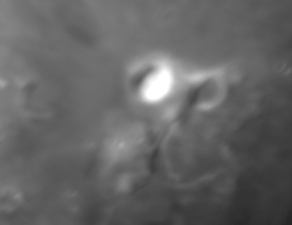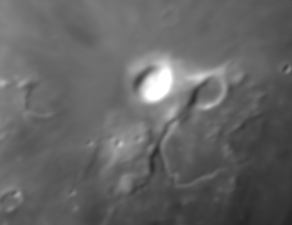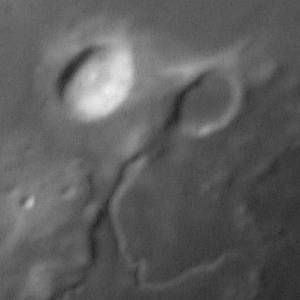
IRIS TUTORIAL
Atmospheric turbulence correction
Morphing is not just a special effect for artistic applications. Morphing techniques have various ranging from lens distortion correction, motion capture data interpolation, waves atmospheric turbulence correction, etc. This section describe the turbulence correction of planetary image (but the procedure is the same for correct optically distorted wide-field CCD images for examples).
The goal of the processing is to resample a target image relative to a reference image for minimize geometrical difference between the two. So, the blurring effect of the turbulence in the Earth's atmosphere is now partially compensated: If you stack the two images (or more), the spatial resolution is increased.
The atmospheric distortion was calculated using DISTOR command.
The syntax is: DISTOR [NAME1] [NAME2] [ORDER]
[NAME1] is the file name of a contrasted reference image.
[NAME2] is the file name of the image to be resampled.
[ORDER] is the order of a 2-D quadratic equation used for fit the distortion.
Range is between 1 (linear correction) and 5 (complex distortion). The recommended
value is 3 or 4 for most the situation. DISTOR use an iterative scheme for aberrant points elimination.
Before running the DISTOR command it is necessary to define some points with mouse in the reference image. If possible, this points mark the position of contrasted details. (light/shadow region on the moon surface, planetary limb, stars, ...). The geometric correction is only valid in the part of the image included into the pointing area (outside of this area Iris extrapolate the information).
STEP 1
First, register the images of the sequence.
Use the Planetary registration (1) command of Processing menu (for correlation
method) or Planetary registration (2) command of Processing menu (for countour
method). The quivalent console commands are PREGISTER and CREGISTER.
For example:
>PREGISTER MOON I 256 72
STEP 2
Select reference points into the reference image (MOON1 images for the example).
These points are used to create the transform model between reference and actual
processed
image. The procedure fit polynomial equations using least squares criteria to
model distortion.
For activate points selection mode check the itemn Select Objects of the Analysis menu:

For an optimal result it is necessary to select contrasted feature in the reference image:

Up to 100 points can be defined. Try to distribute uniformly this points on the image surfaces.
Yyou can now deselect the Select Objets option of the Analysis menu.
STEP 3
Compute the polynomial equations and synthetize the corrected image.
The polynomial transform is a 1st to 5th order polynomial ([ORDER] parameter
of the DISTOR command).
Example:
>DISTOR I1 I9 4
The image I9 is now registered relative to the I1 image. The result can be saved on the disk:
>SAVE R9
For appreciate the result:
>LOAD I1
>SUB R9 5000
>VISU 5100 4900
It is possible to process the sequence images in one
step (DISTROR2 command). The syntax is DISTOR2 [NOM1] [NOM2] [ORDER]
[NUMBER]. The parameter [NUMBER] is the number of images in the
sequence. Example:
>DISTOR2 MOON R 4 72
The reference image is MOON1. The R1...R72 are now registered.
You can stop the processing by clicking the red button of the tool bar.
STEP 4
You can now add the registered images:
>ADD_NORM R 72
or select the best resolved images before composite:
>BESTOF R 72
>SELECT R T
>ADD_NORM T 10


Left, the
result after a simple registration. Right,
use of DISTOR function before stacking.
The animated sequence below is a typical example of strongly degraded images by atmospheric turbulence: left, unprocessed sequence, right the same sequence processed with DISTOR2 command (the turbulence correction is only partial, but significant).

